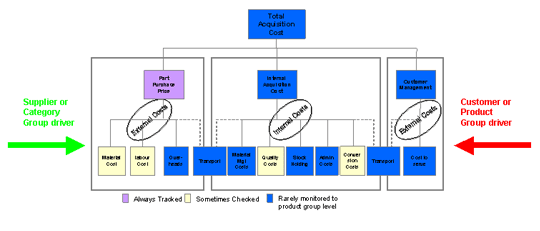| Reducing
Total Acquisition Cost (TAC)
Total Acquisition Cost is the sum of all costs associated
with the delivery of a product or service to your customer.
It normally includes some or all of the following costs:
| |
Customer order
entry & processing |
|
Assembly or conversion
|
| |
Inventory & Waste or yield
|
|
Quality costs |
| |
Administration |
|
Freight
- inbound and outbound |
| |
Order / delivery size costs |
|
Cost to receive and
make ready |
| |
Suppliers raw material, processing
costs and added value activities |
|
Supplier Supply Chain
planning |
| |
|
Acquisition of bought
in materials and servicesSupplier’s raw material
and internal costs |
Supply Chain Excellence’s TAC tool is designed
to allow in depth analysis of costs for either a purchase
category or finished product which has been identified
for study. The tool focuses attention on opportunities
to reduce cost by highlighting the key cost drivers
and sources of waste. Our interactive workshops then
develop action plans which deliver both immediate and
longer term sustainable cost reductions.
Objective - Identify
and eliminate/minimize all non value-added activities
in the supply chain for a nominated product group
Emphasis - Total acquisition
cost of supply and the value it brings to the end product.
It is not intended
to:
– replace existing costing systems - it relies
on data from these and other sources.
– become a full Value Stream Mapping exercise
- it should be simple to implement
Delete - eliminate
non added-value activities
Reduce - minimize or
eliminate usage
Downgrade - ensure
appropriate quality that is ‘fit for purpose’
Substitute - identify
and introduce alternative products or processes
Replace - use something
else
Standardize - minimize
or eliminate complexity
Integrate - mesh in
the processes and activities of production between purchaser
and supplier
Supply Chain Excellence TAC
Process
TAC relies on establishing templates corresponding to
the common acquisition and supply routings utilized
within your business and inviting teams to identify
cost anomalies at the supplier, product and customer
group level.

Benefits from TAC can be defined
in two ways:
| 1.
Direct (hard) savings - Reduction in actual costs,
e.g. |
2.
Indirect savings - Efficiency improvements, e.g |
| |
less packaging |
|
shorter set up times |
| |
lower
component costs |
|
simpler
purchase to pay process |
| |
lower production
costs |
|
reduced stockholding
or VMI |
| |
lower transport
costs |
|
lower process costs |
| |
shared invest |
|
NPD support |
| |
lower inventory |
|
transfer of tasks |
| |
|
Note:
may be possible to accumulate efficiency improvements
to derive hard savings. |
top
|

